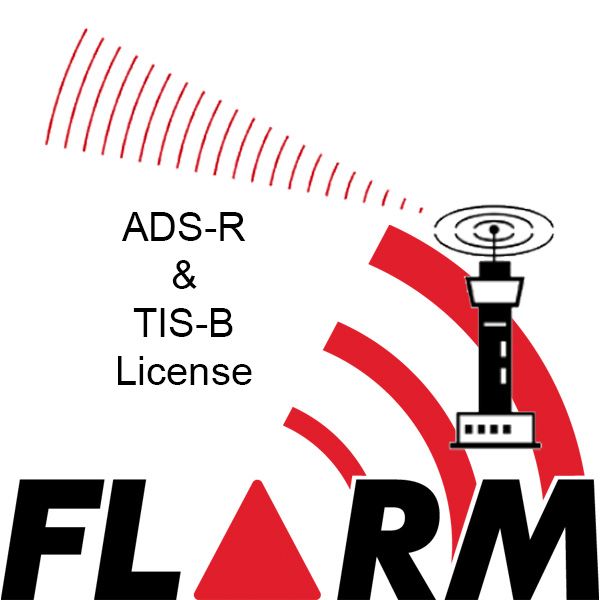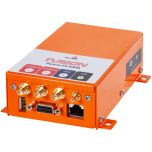FLARM ADS-R & TIS-B License
FLARM ADS-R and TIS-B Reception (ADSR)
General Description
FLARM ADS-R and TIS-B Reception (ADSR) - feature license will activate the reception of ADS-R and TIS-B rebroadcast services in the USA. Requires a PowerFLARM Core ADS-B (p/n FLAPFC11A or FLAPFC10A) or a PowerFLARM Portable (p/n FLAPFP24A or FLAPFP23A ). ADS-R and TIS-B reception is also available in PowerFLARM Fusion without the need for a feature license. Requires firmware version 7.03 or later.
Important! PowerFLARM Core – The serial number is combined with the part number and can be found on the product label and has the form FLAPFC11E–001234. Use the combined part and serial number.
PowerFLARM Portable – The serial number is combined with the part number and can be found on the product label and has the form FLAPFP24E–001234. Use the combined part and serial number.
Licenses are in the form of an email and are processed Monday – Friday during business hours. Please allow up to 24 hours to complete your order.


In the US, most aircraft are equipped with ADS-B Out. ADS-B Out is primarily intended for ATC traffic separation, but the broadcasts are also received by many PowerFLARM devices. If the aircraft, whose broadcast is received, doesn’t also have FLARM, its ADS-B position is used instead.
However, there are two different ADS-B standards in the US: 1090ES (the international standard, using 1090 MHz) and UAT (using 978 MHz). Aircraft may only have one of the systems installed but FLARM devices can only receive 1090ES. Especially in the lower airspace, many light aircraft have chosen UAT, which leaves you vulnerable if these aircraft do not also have FLARM. In addition, some gliders in the US still don’t have FLARM, and in many cases, the same gliders are also not equipped with ADS-B Out.


UAT and no-FLARM traffic invisible without ADS-R/TIS-B
Two parallel technologies, ADS-R and TIS-B, are offered by the FAA. Aircraft reports with the “wrong” ADS-B standard, or without any ADS-B Out, are rebroadcast for others to receive.
Starting with firmware version 7.03, PowerFLARM Fusion, PowerFLARM Core ADS‑B, and PowerFLARM Portable can receive ADS-R and TIS-B. This makes aircraft with UAT or just a transponder visible as well! This functionality is included with Fusion and offered as an option for Core and Portable. Aircraft received via ADS-R or TIS-B will be shown on the display similar to how ADS-B aircraft are shown. However, because of the lower accuracy of the position, collision warnings are not issued.
ADS-R
Automatic Dependent Surveillance – Rebroadcast (ADS-R) is an FAA service that rebroadcasts positions of aircraft that have a UAT ADS-B Out equipment on 1090 MHz and vice versa. This is done using FAA ground stations and the purpose is that aircraft with ADS-B In on only 1090 MHz should be able to also see UAT aircraft (and vice versa).
TIS-B
Traffic Information Services – Broadcast (TIS-B) is similar to ADS-R but instead broadcasts positions of transponder-only equipped aircraft. These aircraft are received by FAA secondary surveillance radars (SSR) so the positions are not as accurate as ADS-R.


When are ADS-R and TIS-B Reports Issued?
FAA ground stations issue ADS-R and TIS-B rebroadcast only if there is demand. Rebroadcast is not supported in all regions. To be considered as a client for rebroadcast and thus activating the on-demand system, an aircraft must:
Be in a region where ADS-R/TIS-B is offered by the FAA
Be ADS-B Out equipped (either 1090ES or UAT) and have produced valid position data within the last 30 seconds
The ADS-B Out equipment must be programmed to communicate that the aircraft is capable of ADS-B In on 1090 MHz — but not of UAT In.
Positions reports are rebroadcast in a defined range around the client (called the “hockey puck”).


You can check whether your own ADS-B Out configuration correctly qualifies the aircraft as a rebroadcast client by filing a Public ADS-B Performance Report Request on the FAA website after a flight.
No ADS-B Out?
If you do not have ADS-B Out (or your equipment is not broadcasting to the FAA that you are capable of ADS-B In on 1090 MHz), you can still benefit from the same position information that is sent to other nearby aircraft. In this case, the reliability of traffic reports will vary with the traffic density, i.e. the probability of a nearby aircraft qualifying as a rebroadcast client.
Conclusion and Limitations
ADS-R and TIS-B provide an essential means of interoperability between three disjunct technologies. This is very much needed and a huge safety benefit. The system also brings new complexities that need to be managed. Many conditions need to be met to get position reports, which may reduce the predictability of traffic reports somewhat compared to direct methods:
The local infrastructure supports rebroadcasting
The critical traffic is received by the (same) infrastructure
Your (or a nearby) aircraft qualifies (and is recognized by FFA infrastructure) as a client













